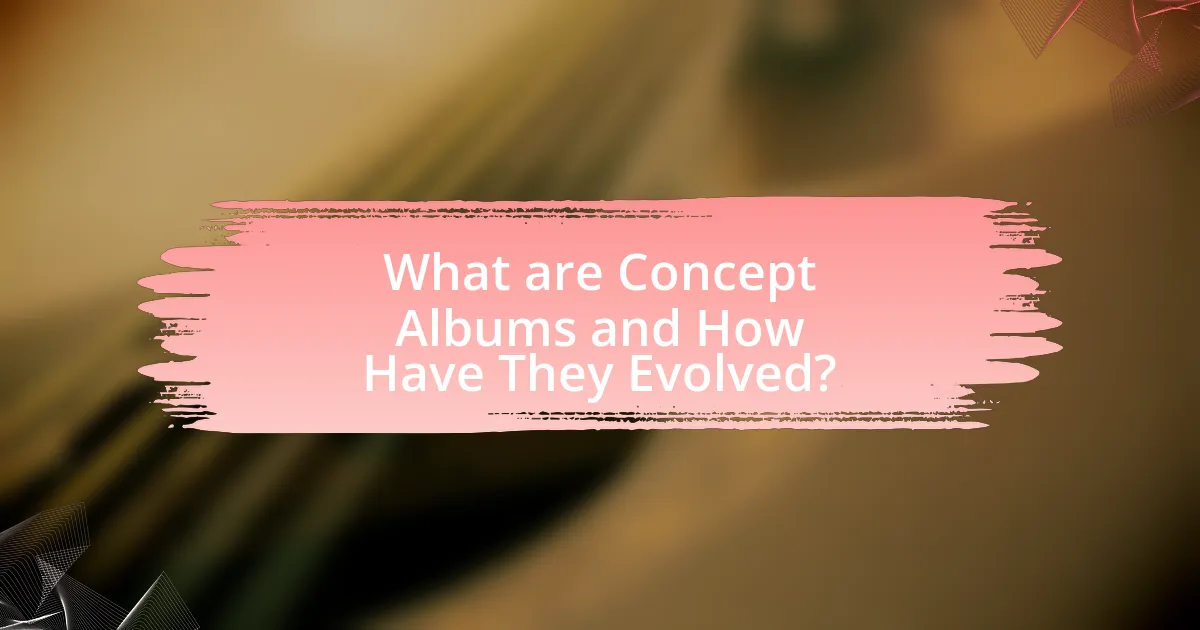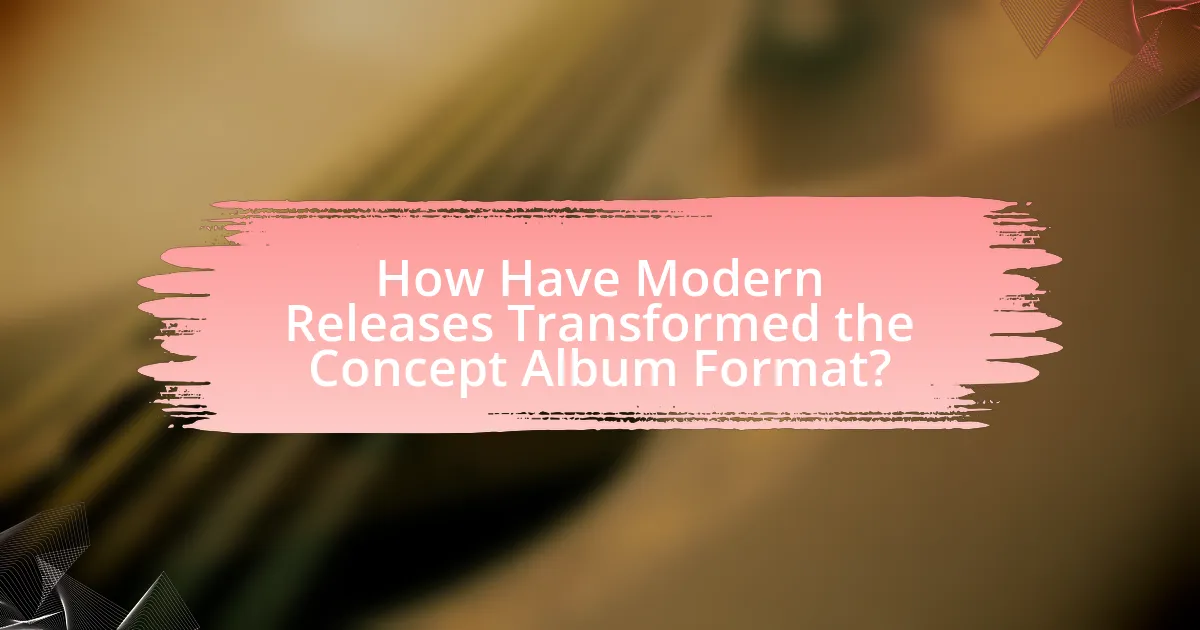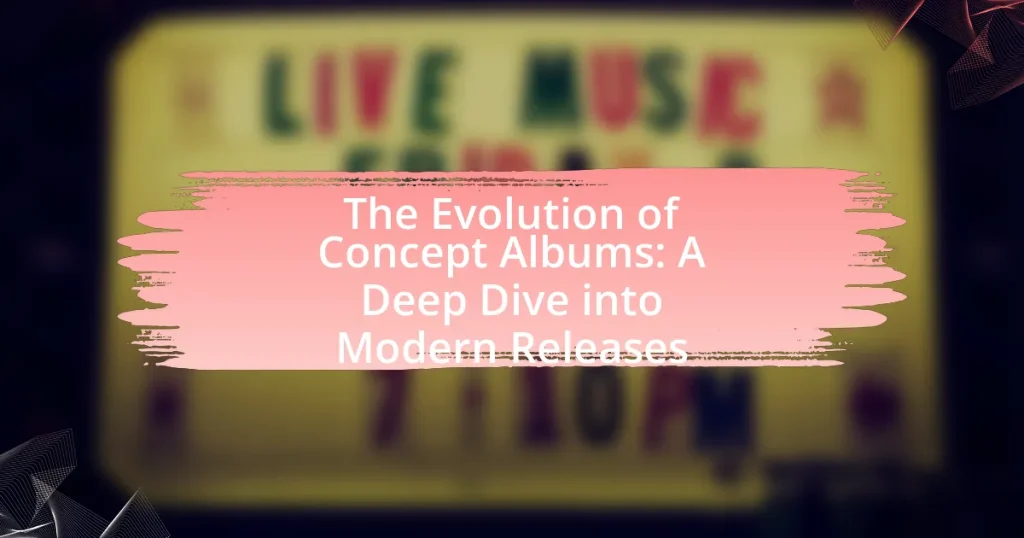Concept albums are musical works unified by a central theme or narrative, evolving significantly since their inception in the 1960s with artists like The Beatles and Pink Floyd. This article explores the defining characteristics of concept albums, their differences from traditional albums, and the historical and technological influences that have shaped their development. It also examines notable examples from both early and modern releases, highlighting how contemporary artists integrate multimedia elements and storytelling to enhance listener engagement. Additionally, the article addresses the challenges and opportunities faced by artists in creating concept albums today, emphasizing the relevance of this format in the current music landscape.

What are Concept Albums and How Have They Evolved?
Concept albums are musical works that are unified by a central theme or narrative, often telling a story or exploring a specific concept throughout the tracks. The evolution of concept albums began in the 1960s with artists like The Beatles and Pink Floyd, who used the format to create cohesive listening experiences rather than just collections of individual songs. Over the decades, the concept album has adapted to various genres, with notable examples including The Who’s “Tommy” and more recently, Kendrick Lamar’s “To Pimp a Butterfly,” which addresses complex social issues. This evolution reflects changes in music production, audience expectations, and the integration of multimedia elements, demonstrating the concept album’s enduring relevance in contemporary music.
What defines a concept album in music?
A concept album in music is defined as a collection of songs that are unified by a central theme or narrative. This thematic coherence often guides the album’s structure and flow, creating a cohesive listening experience. For example, Pink Floyd’s “The Wall” explores themes of isolation and personal struggle, illustrating how a concept album can convey a story or message through its tracks. The use of interludes, recurring motifs, and a deliberate sequence of songs further reinforces the concept, making it distinct from traditional albums that may not adhere to a singular narrative.
How do concept albums differ from traditional albums?
Concept albums differ from traditional albums primarily in their narrative structure and thematic coherence. While traditional albums typically consist of a collection of standalone songs, concept albums are designed around a central theme or story that unfolds throughout the tracks. This approach allows for a more immersive listening experience, as evidenced by iconic examples like Pink Floyd’s “The Wall,” which explores complex themes of isolation and societal issues through its interconnected songs. The intentional arrangement of tracks in concept albums often enhances the emotional impact and artistic expression, distinguishing them from the more varied and less cohesive nature of traditional albums.
What are the key elements that make up a concept album?
A concept album is characterized by a cohesive theme or narrative that unifies the songs. Key elements include a central storyline or concept, which guides the lyrical content and musical composition throughout the album. Additionally, the sequencing of tracks is crucial, as it enhances the flow and progression of the narrative. The use of recurring motifs or musical themes across different songs further reinforces the album’s cohesiveness. Concept albums often incorporate interludes or transitions that connect tracks, creating a seamless listening experience. Historical examples, such as Pink Floyd’s “The Wall” and The Who’s “Tommy,” illustrate how these elements work together to create a compelling artistic statement.
Why did concept albums gain popularity in the music industry?
Concept albums gained popularity in the music industry due to their ability to provide a cohesive narrative and artistic expression that resonates with listeners. This format allows artists to explore complex themes and emotions over an extended playtime, creating a more immersive experience. The rise of rock and progressive genres in the 1960s and 1970s, exemplified by albums like Pink Floyd’s “The Dark Side of the Moon,” showcased the potential of concept albums to elevate music beyond mere entertainment to a form of storytelling. Additionally, advancements in recording technology and the shift towards album-oriented rock encouraged musicians to craft albums as unified works rather than collections of singles, further solidifying the concept album’s place in popular culture.
What historical events influenced the rise of concept albums?
The rise of concept albums was significantly influenced by the cultural and technological shifts of the 1960s, particularly the counterculture movement and advancements in recording technology. The counterculture movement, characterized by a rejection of mainstream values and an embrace of artistic experimentation, encouraged musicians to create cohesive works that conveyed a narrative or thematic unity. This period saw artists like The Beatles with “Sgt. Pepper’s Lonely Hearts Club Band” in 1967, which is often cited as a pioneering concept album, showcasing the potential of the album format to tell a story or explore complex themes. Additionally, the introduction of multi-track recording technology allowed for more intricate arrangements and production techniques, enabling artists to craft elaborate soundscapes that complemented their narratives. These historical events collectively fostered an environment where concept albums could flourish, leading to their establishment as a respected art form in popular music.
How did technology impact the production of concept albums?
Technology significantly impacted the production of concept albums by enabling advanced recording techniques and digital manipulation. Innovations such as multi-track recording, synthesizers, and digital audio workstations allowed artists to layer sounds, create complex arrangements, and experiment with new musical styles. For instance, the use of digital sampling in albums like “The Dark Side of the Moon” by Pink Floyd showcased how technology could enhance storytelling through soundscapes. Additionally, the rise of the internet facilitated the distribution and promotion of concept albums, allowing artists to reach wider audiences and engage with fans directly. This technological evolution has transformed the creative process, making it more accessible and diverse for musicians.
What are some notable examples of early concept albums?
Notable examples of early concept albums include “The Beatles’ Sgt. Pepper’s Lonely Hearts Club Band,” released in 1967, which is often credited with popularizing the format. Another significant example is “The Who’s Tommy,” released in 1969, which tells a cohesive story through its tracks. Additionally, “Pink Floyd’s The Piper at the Gates of Dawn,” released in 1967, is recognized for its thematic continuity and experimental sound. These albums are foundational in establishing the concept album as a legitimate artistic form in popular music.
Which artists pioneered the concept album format?
The artists who pioneered the concept album format include Frank Sinatra, The Beatles, and The Who. Frank Sinatra’s 1946 album “Songs for Young Lovers” is often cited as one of the first concept albums, as it presented a cohesive theme throughout its tracks. The Beatles further popularized the format with their 1967 album “Sgt. Pepper’s Lonely Hearts Club Band,” which is recognized for its artistic unity and narrative structure. Additionally, The Who’s 1969 album “Tommy” is considered a landmark in the genre, as it tells a complete story through its songs. These artists laid the groundwork for the concept album format, influencing countless musicians in subsequent decades.
What themes were commonly explored in early concept albums?
Early concept albums commonly explored themes of storytelling, personal journeys, and social commentary. These albums often presented a cohesive narrative or thematic arc, allowing artists to delve into complex emotions and societal issues. For instance, The Beatles’ “Sgt. Pepper’s Lonely Hearts Club Band” (1967) is a seminal example that blends fictional personas with reflections on contemporary culture. Similarly, Pink Floyd’s “The Wall” (1979) addresses themes of isolation and alienation, illustrating the psychological struggles of its protagonist. These thematic explorations not only defined the genre but also influenced subsequent musical works, establishing a framework for artists to convey deeper messages through their albums.

How Have Modern Releases Transformed the Concept Album Format?
Modern releases have transformed the concept album format by integrating diverse multimedia elements and narrative complexity, enhancing the storytelling aspect of albums. Artists now utilize digital platforms to create immersive experiences, often incorporating visuals, interactive content, and cross-platform storytelling that extends beyond traditional audio formats. For instance, albums like “Lemonade” by Beyoncé and “The Rise and Fall of Ziggy Stardust and the Spiders from Mars” by David Bowie exemplify how modern releases leverage visual storytelling and thematic depth, allowing listeners to engage with the narrative on multiple levels. This evolution reflects a shift in how artists conceptualize and present their work, moving from linear storytelling to more intricate, interconnected narratives that resonate with contemporary audiences.
What are the characteristics of modern concept albums?
Modern concept albums are characterized by a cohesive narrative or thematic structure that connects the individual tracks, often exploring complex themes such as identity, social issues, or personal experiences. These albums frequently utilize innovative production techniques, blending various musical genres to enhance storytelling, as seen in works like Kendrick Lamar’s “To Pimp a Butterfly,” which addresses systemic racism and personal struggle through a unified musical and lyrical journey. Additionally, modern concept albums often incorporate multimedia elements, such as visual art or accompanying videos, to deepen the listener’s engagement and understanding of the narrative, exemplified by Beyoncé’s “Lemonade,” which combines music with powerful imagery and social commentary.
How do modern concept albums incorporate multimedia elements?
Modern concept albums incorporate multimedia elements by integrating visual art, video content, and interactive experiences alongside the music. Artists often release accompanying music videos that enhance storytelling, such as the visual narratives seen in albums like Beyoncé’s “Lemonade,” which combines music with film to deepen thematic exploration. Additionally, some albums feature augmented reality apps or websites that allow listeners to engage with the content in innovative ways, exemplified by the interactive elements in Gorillaz’s projects. This multimedia approach not only enriches the listener’s experience but also expands the artistic expression of the album, making it a more immersive and cohesive work.
What role does storytelling play in contemporary concept albums?
Storytelling serves as a foundational element in contemporary concept albums, enhancing the listener’s experience by creating a cohesive narrative that ties together individual tracks. This narrative structure allows artists to explore complex themes and emotions, often reflecting societal issues or personal journeys. For instance, albums like “The Wall” by Pink Floyd and “To Pimp a Butterfly” by Kendrick Lamar utilize storytelling to convey messages about alienation and racial identity, respectively. The integration of storytelling in these works not only engages listeners but also invites them to interpret and connect with the material on a deeper level, thereby solidifying the concept album’s role as a significant artistic medium in modern music.
Why are modern concept albums relevant in today’s music scene?
Modern concept albums are relevant in today’s music scene because they provide a cohesive narrative experience that resonates with listeners seeking deeper engagement. This format allows artists to explore complex themes and emotions, often reflecting societal issues, personal journeys, or artistic statements. For instance, albums like “To Pimp a Butterfly” by Kendrick Lamar and “The Wall” by Pink Floyd have garnered critical acclaim for their storytelling and thematic depth, illustrating how concept albums can elevate the listening experience beyond mere entertainment. The resurgence of vinyl and the popularity of streaming platforms have further facilitated the appreciation of albums as complete works, encouraging artists to craft intricate narratives that captivate audiences.
How do modern artists use concept albums to connect with audiences?
Modern artists use concept albums to connect with audiences by creating cohesive narratives that engage listeners on emotional and intellectual levels. These albums often explore complex themes, allowing artists to express personal stories or societal issues, which fosters a deeper connection with fans. For instance, Kendrick Lamar’s “To Pimp a Butterfly” addresses racial identity and social justice, resonating with listeners who relate to these themes. Additionally, the immersive experience of a concept album encourages audiences to engage with the music as a whole, rather than just individual tracks, enhancing their emotional investment. This approach has been validated by studies showing that narrative-driven music can lead to increased listener empathy and understanding, further solidifying the bond between artists and their audiences.
What trends are emerging in the production of modern concept albums?
Emerging trends in the production of modern concept albums include the integration of multimedia elements, collaborative efforts across genres, and a focus on narrative depth. Artists increasingly incorporate visual storytelling through music videos and interactive experiences, enhancing the listener’s engagement. Collaborations between artists from different genres are becoming more common, allowing for diverse soundscapes and broader audience reach. Additionally, there is a growing emphasis on thematic coherence and storytelling, with albums often exploring complex social issues or personal narratives, as seen in works like Kendrick Lamar’s “To Pimp a Butterfly,” which addresses systemic racism and personal struggle. These trends reflect a shift towards a more immersive and interconnected approach to music production.
What are some recent examples of successful concept albums?
Recent examples of successful concept albums include “The Age of Adz” by Sufjan Stevens, released in 2010, and “To Pimp a Butterfly” by Kendrick Lamar, released in 2015. “The Age of Adz” explores themes of love, loss, and mental health, while “To Pimp a Butterfly” addresses systemic racism and personal identity. Both albums received critical acclaim, with “To Pimp a Butterfly” winning the Grammy Award for Best Rap Album and being hailed as one of the greatest albums of all time by various publications.
How have these albums been received by critics and fans?
The albums have generally received positive reviews from both critics and fans. Critics have praised the innovative storytelling and cohesive themes present in the albums, often highlighting their artistic depth and production quality. For instance, several music publications have awarded high ratings, indicating strong approval. Fans have also responded favorably, as evidenced by high streaming numbers and enthusiastic social media engagement, reflecting a strong connection to the material. This dual appreciation from critics and fans underscores the albums’ successful impact within the concept album genre.
What themes are prevalent in recent concept album releases?
Recent concept album releases frequently explore themes of identity, mental health, and social issues. Artists are increasingly using their work to reflect personal struggles and societal challenges, as seen in albums like “The Age of Adz” by Sufjan Stevens, which delves into themes of mental illness and existentialism, and “To Pimp a Butterfly” by Kendrick Lamar, which addresses racial identity and systemic oppression. These thematic choices resonate with listeners, providing both a personal connection and a broader commentary on contemporary life.

What Challenges and Opportunities Exist for Future Concept Albums?
Future concept albums face challenges such as market saturation and the decline of physical media, which can hinder artists’ ability to reach audiences effectively. The rise of digital streaming has shifted focus towards singles rather than cohesive albums, making it difficult for artists to maintain narrative depth. However, opportunities exist in the form of innovative storytelling through multimedia integration, such as visual components and interactive experiences, which can enhance listener engagement. Additionally, platforms like Bandcamp and Patreon allow artists to connect directly with fans, fostering a supportive community for concept-driven projects. These dynamics illustrate the evolving landscape of concept albums, where adaptability and creativity can lead to successful outcomes despite inherent challenges.
What challenges do artists face when creating concept albums today?
Artists face several challenges when creating concept albums today, primarily due to the evolving music industry landscape. One significant challenge is the pressure to produce commercially viable music, which often conflicts with the artistic freedom required for a cohesive concept album. Additionally, the rise of digital streaming platforms has shifted listener preferences towards singles rather than full albums, making it difficult for artists to engage audiences with a longer narrative format.
Moreover, the need for extensive marketing and promotion in a saturated market can detract from the creative process, as artists must balance their artistic vision with the demands of visibility and audience engagement. According to a 2021 report by the International Federation of the Phonographic Industry, 70% of music consumption now occurs through streaming, emphasizing the trend away from traditional album formats. This environment creates a significant hurdle for artists aiming to craft intricate, story-driven works that require listener investment and attention.
How do market trends affect the viability of concept albums?
Market trends significantly influence the viability of concept albums by shaping consumer preferences and industry standards. As streaming services dominate music consumption, listeners increasingly favor singles and playlists over full albums, which can diminish the market potential for concept albums that require a cohesive listening experience. For instance, a report from the International Federation of the Phonographic Industry (IFPI) in 2022 indicated that 70% of music consumption was driven by playlists, highlighting a shift away from traditional album formats. Consequently, artists may find it challenging to justify the investment in concept albums if market trends continue to prioritize fragmented listening experiences over comprehensive narratives.
What are the financial implications of producing a concept album?
Producing a concept album typically incurs higher financial implications compared to standard albums due to increased production costs, marketing expenses, and potential for lower initial sales. The complexity of a concept album often requires more extensive studio time, specialized musicians, and intricate arrangements, which can elevate production costs by 20-50% compared to traditional albums. Additionally, marketing a concept album may necessitate unique promotional strategies, further increasing expenses. However, successful concept albums can lead to higher long-term revenue through merchandise sales, concert tours, and streaming royalties, as they often create a dedicated fanbase. For instance, Pink Floyd’s “The Wall” generated significant revenue through its innovative approach and enduring popularity, illustrating the potential for financial success despite initial costs.
What opportunities can artists leverage in the concept album format?
Artists can leverage several opportunities in the concept album format, including storytelling, thematic exploration, and audience engagement. The concept album allows artists to create a cohesive narrative that can deepen listener connection, as seen in works like Pink Floyd’s “The Wall,” which explores complex themes of isolation and mental health. Additionally, artists can use the format to experiment with musical styles and production techniques, as demonstrated by Kendrick Lamar’s “To Pimp a Butterfly,” which blends genres to enhance its social commentary. This format also provides opportunities for marketing and promotional strategies, such as immersive experiences and visual storytelling, which can attract a dedicated fanbase and increase overall engagement.
How can technology enhance the experience of concept albums?
Technology can enhance the experience of concept albums by providing immersive audio-visual elements that deepen listener engagement. For instance, advancements in streaming platforms allow artists to integrate visuals, such as music videos or interactive artwork, directly with their albums, creating a multi-sensory experience. Additionally, technologies like augmented reality (AR) and virtual reality (VR) enable fans to explore the themes and narratives of concept albums in innovative ways, such as through virtual concerts or interactive storytelling apps. This integration of technology not only enriches the narrative but also fosters a stronger emotional connection between the artist and the audience, as evidenced by projects like Björk’s “Biophilia,” which utilized apps to explore the album’s themes interactively.
What strategies can artists use to promote their concept albums effectively?
Artists can promote their concept albums effectively by leveraging social media platforms, engaging with fans through storytelling, and utilizing multimedia content. Social media allows artists to reach a broad audience, with platforms like Instagram and TikTok enabling them to share behind-the-scenes content, snippets of songs, and visual art that complements the album’s theme. Engaging storytelling helps create a narrative around the album, making it more relatable and memorable for listeners. Additionally, multimedia content such as music videos, live performances, and interactive experiences can enhance the album’s concept and attract attention. According to a 2021 study by the International Journal of Music Business Research, artists who actively engage with their audience on social media see a 30% increase in album sales compared to those who do not.
What best practices should artists follow when creating a concept album?
Artists should ensure a cohesive narrative throughout their concept album to effectively convey the intended theme or story. This involves carefully planning the album’s structure, including the sequence of tracks, to create a logical flow that enhances the listener’s experience. Additionally, artists should develop strong lyrical content that aligns with the overarching concept, as demonstrated by Pink Floyd’s “The Wall,” which integrates storytelling with musical composition. Collaborating with other musicians and producers can also enrich the album’s sound and depth, as seen in The Beatles’ “Sgt. Pepper’s Lonely Hearts Club Band,” where diverse influences contributed to its innovative approach. Finally, artists should consider visual elements, such as album artwork and music videos, to complement the audio experience and reinforce the concept, similar to how David Bowie utilized visual storytelling in his albums.


